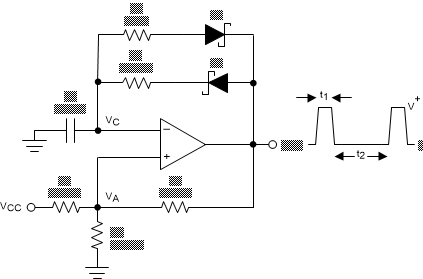SNOSDJ3 May 2024 TLV1812-EP
ADVANCE INFORMATION
- 1
- 1Features
- 2Applications
- 3Description
- Pin Configuration and Functions
- 4Specifications
- 5Detailed Description
-
6Application and Implementation
- 6.1 Application Information
- 6.2 Typical Applications
- 6.3 Power Supply Recommendations
- 6.4 Layout
- 7Device and Documentation Support
- 8Revision History
- 9Mechanical, Packaging, and Orderable Information
6.2.3 Adjustable Pulse Width Generator
Figure 6-12 is a variation of the square wave oscillator (see Figure 6-9) that allows adjusting the pulse widths.
R4 and R5 provide separate charge and discharge paths for the capacitor C depending on the output state.
 Figure 6-12 Adjustable Pulse Width Generator
Figure 6-12 Adjustable Pulse Width GeneratorThe charge path is set through R5 and D2 when the output is high. Similarly, the discharge path for the capacitor is set by R4 and D1 when the output is low.
The pulse width t1 is determined by the RC time constant of R5 and C. Thus, the time t2 between the pulses can be changed by varying R4, and the pulse width can be altered by R5. The frequency of the output can be changed by varying both R4 and R5. At low voltages, the effects of the diode forward drop (0.8 V, or 0.15V for Shottky) must be taken into account by altering output high and low voltages in the calculations.